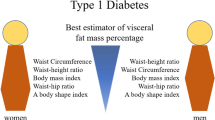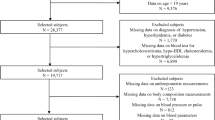Abstract
OBJECTIVE: To determine the relation of skeletal body build and obesity to blood pressure and the prevalence of hypertension.
DESIGN: Cross-sectional data obtained from the baseline recruitment of the EPIC-Potsdam Study, which is part of the European Prospective Investigation into Cancer and Nutrition (EPIC).
SUBJECTS: A total of 10 303 subjects (4387 men, aged 40–65 y and 5916 women, aged 35–65 y) were recruited between January 1995 and July 1996.
MEASUREMENTS: Anthropometric measures included body mass index (BMI), waist-hip ratio (WHR) and metrik index (MIX) as a measure of body build that is derived from the relation of chest depth and breadth to body height. Systolic and diastolic blood pressure was obtained using automatic oscillometric devices. Hypertension was defined as blood pressure ≥160/95 mmHg or current use of antihypertensive medication. Information on lifestyle factors were obtained by personal interview.
STATISTICAL ANALYSIS: Logistic regression was used to define the association of categories of BMI, WHR, and MIX and the prevalence of hypertension. Odds ratios (ORs) of being hypertensive were estimated comparing the highest to the lowest quintile, adjusting for age, smoking status, alcohol intake level, educational attainment, physical activity categories, and each of the anthropometric variables.
RESULTS: The simultaneously adjusted OR of being hypertensive, comparing the highest vs the lowest category, was for BMI 2.3 (95% confidence interval (CI)=1.6–3.2) in men and 1.8 (95% CI=1.4–2.5) in women, for WHR 1.8 (95% CI=1.4–2.4) in men and 1.5 (95% CI=1.2–2.0) in women, and for MIX (largest chest size vs lowest chest size relative to body height) 2.0 (95% CI=1.4–2.8) in men and 2.2 (95% CI=1.6–3.1) in women.
CONCLUSION: In addition to measures of overall obesity (BMI) as well as central obesity (WHR), skeletal body build (MIX) was independently associated with the prevalence of hypertension. The biological mechanism relating MIX to hypertension, however, is still unclear and needs further exploration.
This is a preview of subscription content, access via your institution
Access options
Subscribe to this journal
Receive 12 print issues and online access
$259.00 per year
only $21.58 per issue
Buy this article
- Purchase on Springer Link
- Instant access to full article PDF
Prices may be subject to local taxes which are calculated during checkout
Similar content being viewed by others
Author information
Authors and Affiliations
Rights and permissions
About this article
Cite this article
Kroke, A., Bergmann, M., Klipstein-Grobusch, K. et al. Obesity, body fat distribution and body build: Their relation to blood pressure and prevalence of hypertension. Int J Obes 22, 1062–1070 (1998). https://doi.org/10.1038/sj.ijo.0800727
Received:
Revised:
Accepted:
Published:
Issue Date:
DOI: https://doi.org/10.1038/sj.ijo.0800727
Keywords
This article is cited by
-
Increases in Weight and Body Size Increase the Odds for Hypertension During 7 Years of Follow‐up
Obesity (2008)
-
Association between diabetes mellitus and hypertension with anthropometric indicators in older adults: Results of the Mexican Health Survey, 2000
The Journal of Nutrition Health and Aging (2008)
-
Comparison of relative and attributable risk of myocardial infarction and stroke according to C-reactive protein and low-density lipoprotein cholesterol levels
European Journal of Epidemiology (2007)
-
Improvement of blood pressure control in a hypertension clinic: a 10-year follow-up study
Journal of Human Hypertension (2004)
-
Body weight changes and the A-6G polymorphism of the angiotensinogen gene
International Journal of Obesity (2002)



